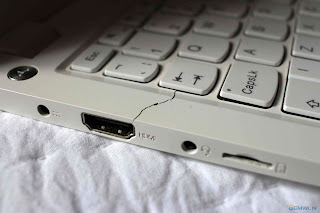How to Open an HP Laptop & Replace the Fan
The purpose of each notebook cooling
fan is to adjust the temperature of the CPU or processor chip. If the fan is
broken, the CPU will overheat, causing serious damage to the motherboard and
any nearby hardware. At this time, we need to replace the internal fan of the laptop
so that the computer can properly dissipate and running.
Screwdriver set
Anti-static wrist strap
Guitar pick
1. Turn off the notebook and
disconnect all power from the HP laptop. Close the LCD screen and place the
notebook face down.
2. Remove the Phillips head screw that
secures the hard drive cover to the lower right corner of the notebook. Remove
the cover from the laptop. Remove any Phillips head screws that secure the hard
drive to its compartment. Slide the hard drive to the right and remove the hard
drive from the notebook.
3. Locate the large RAM and wireless
card cover in the center of the notebook. Remove the fixed Phillips head
screws. Remove the cover from the laptop. A fixed locker is unfolded on both
sides of the RAM module. Tilt the module at an angle and slide it out of the
RAM compartment. Repeat this step to remove each module.
4. Disconnect the two antenna cables
from the wireless network card. Remove the two Phillips head screws that secure
the wireless card to the system board. Remove the wireless network card from
your laptop. Take a CMOS battery out of its compartment.
5. Locate the CD/DVD drive on the left
side of the RAM compartment. Remove the single fixed Phillips head screw of the
drive from the upper left corner of the RAM bay. Grasp the surface of the drive
and slide it out of its compartment. Remove all remaining Phillips head screws
from the bottom case of the notebook. Depending on the laptop model, there may
be up to 30 screws.
6. Turn the laptop over and pull the
LCD screen open. Insert a flat-blade screwdriver into the lower right side of
the keyboard bezel located above the keyboard. Lift the baffle strip, but do
not remove it completely. It has two cables connected to it and needs to be
disconnected later. Place the bezel face down on the work surface of the
notebook so that it does not prevent you from using the keyboard.
7.If necessary, remove any Phillips
head screws that secure the keyboard in place. Grab the top edge of the
keyboard. Remove the keyboard from its compartment and place it face down on
the touchpad. Disconnect the ribbon cable from the keyboard to the motherboard.
Remove the keyboard from your laptop.
8.Locate the black ribbon cable from the left side of the
bezel strip. Disconnect their connections to the motherboard. Remove the bezel
strip from the laptop.
9.Locate and disconnect the LCD video cable on the left side of the
LCD. Remove the Phillips screws from each LCD hinge and remove the LCD panel
from the notebook.
10. Locate the touchpad cable above
the touchpad area. Disconnect the cable from the motherboard. Remove all
remaining Phillips head screws from the upper case of the notebook. Insert the
guitar pad into the gap at the outer edge of the notebook to separate the top
and bottom covers. Pick up the top case with a guitar pick. Remove the top
cover from the laptop.
11. Disconnect all cables connected to
the motherboard. Remove the Phillips head screws that secure the motherboard to
the bottom case of the notebook. Slowly remove the motherboard from the base of
the notebook and check for any attached cables at the bottom of the motherboard.
Disconnect all remaining cables connected to the bottom of the motherboard.
12. Take the motherboard out of the
notebook and turn it over. Place the motherboard on a soft, clean surface.
Locate the cooling fan assembly.
Remove the fixed Phillips head screws. Disconnect the fan power cable from the
motherboard. Remove the fan from the motherboard.
The steps for replacing the different
models of HP laptop fans are not the same, but the general steps are as above,
you can replace some tutorials to complete the replacement of the damaged fan.
For more notebook repair accessories, laptop
screen/laptop keyboard and repair
tutorials please refer to GEMWON.



评论
发表评论